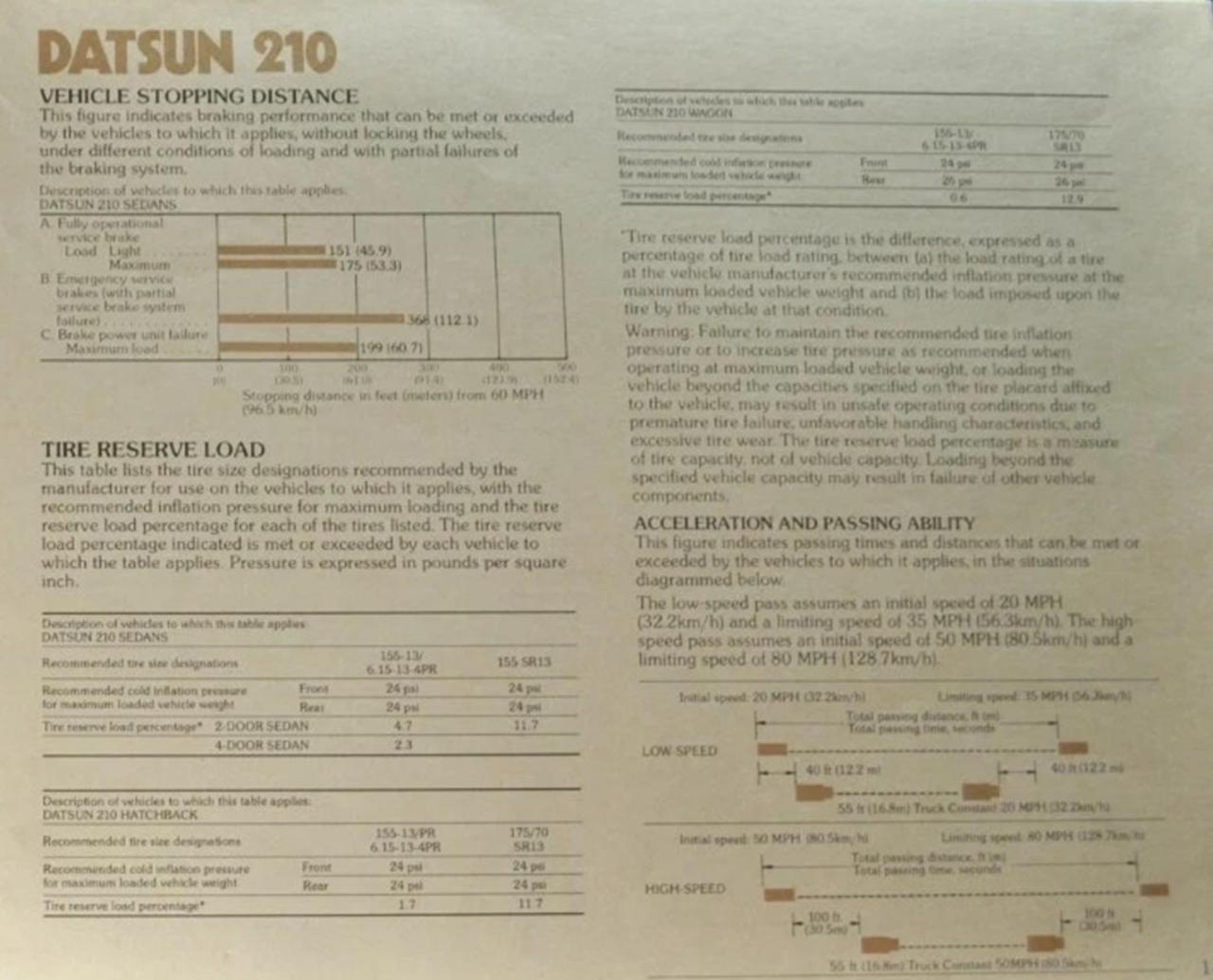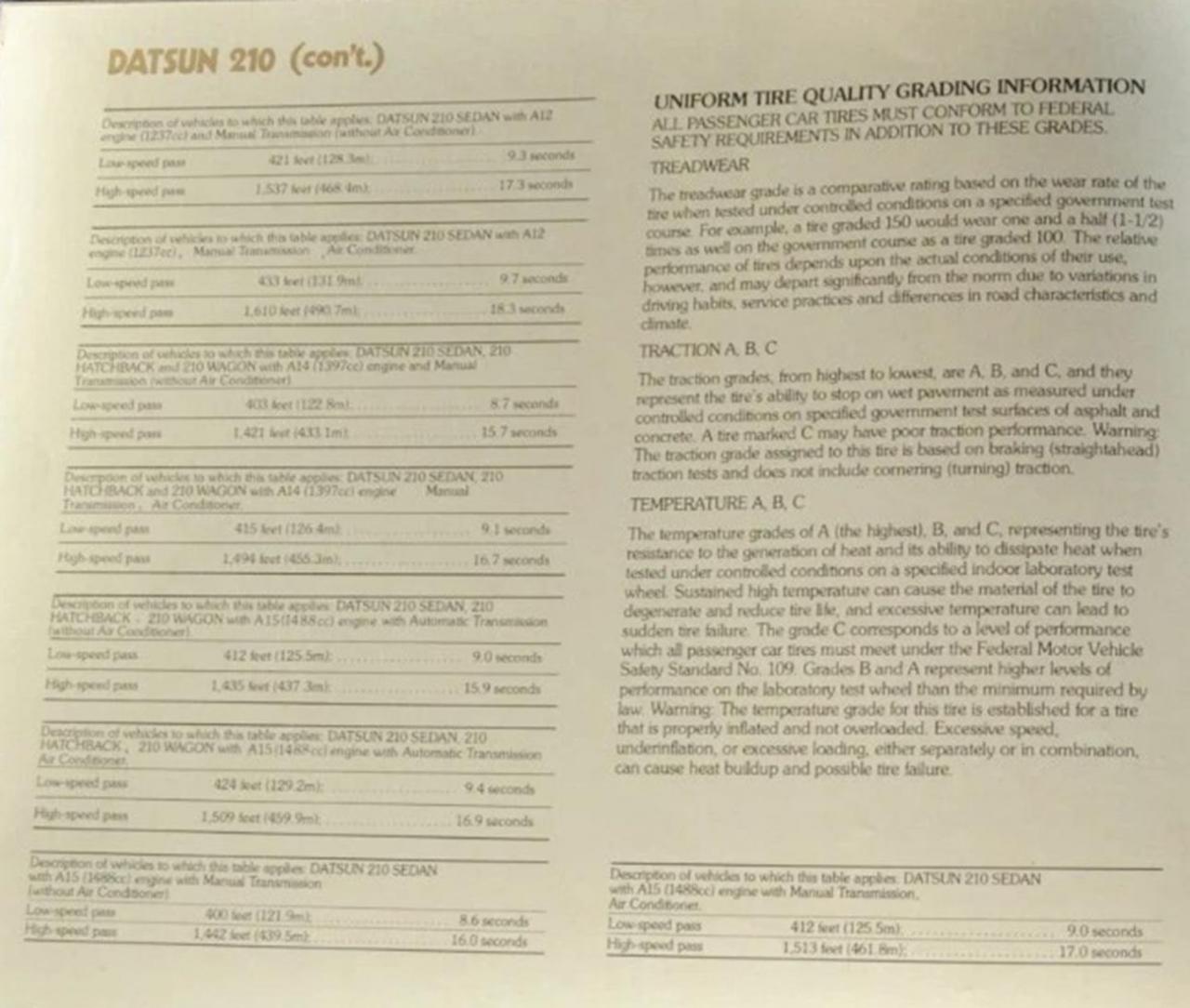<-- back to Consumer Information
USA Datsun B310 "210" improved braking down to 151-175 ft from the B110's 195-190 ft.
Contents |
TABLE OF CONTENTS
1-2 210s 3-4 310s 4-6 510s 6-7 200-SX 8-9 280-ZX/280-ZX 2+2 10-11 810 11-12 720 Pickup Trucks
FOREWORD
This guide contains information on vehicle stopping distances, tire reserve loads and acceleration and passing ability as required by the National Highway Traffic Safety Administration of the U.S. Department of Transportation.
Before driving your new Datsun, we recommend that you take time to review the data so that you will become familiar with the potential ability of the vehicle.
The figures in each summary table apply to all vehicles within the model category identified at the head of the table.
The results shown for "Vehicle Stopping Distance and "Acceleration and Passing Ability" are obtainable by skilled drivers under controlled road and vehicle conditions and may not be correct under other conditions.
Your Datsun dealer will be happy to answer any questions you may have regarding the data.
NISSAN MOTOR CORP. IN U.S.A.
Carson, California
210
VEHICLE STOPPING DISTANCE
DATSUN 210
VEHICLE STOPPING DISTANCE
This figure indicates braking performance that can be met or exceeded by the vehicles to which it applies, without locking the wheels, under different conditions of loading and with partial failures of the braking system.
Description of vehicles to which this table applies:
DATSUN 210 SEDANS
A. Fully operational service brake Load Light: 151 (45.9) Maximum: 175 (53.3) Stopping distance in feet from 60 mph. B. Emergency service brakes: 368 (112.1) (with partial service brake system failure) C. Brake power unit failure: 199 (60.7) Maximum load
Stopping distance in feet (meters) from 60 MPH (96.5 km/h)
TIRE RESERVE LOAD
TIRE RESERVE LOAD
This table lists the tire size designations recommended by the manufacturer for use on the vehicles to which it applies, with the recommended inflation pressure for maximum loading and the tire reserve load percentage for each of the tires listed. The tire reserve load percentage indicated is met or exceeded by each vehicle to
which the table applies. Pressure is expressed in pounds per square inch.
Description of vehicles to which this table applies:
DATSUN 210 SEDANS
Recommended tire size 155-13/ designations 6.15-13-4PR 155 SR13 Recommended cold inflation pressure for maximum loaded vehicle weight Front 24 psi 24 psi Rear 24 psi 24 psi Tire reserve load percentage* 2-DOOR SEDAN 4.7 11.7 4-DOOR SEDAN 2.3
Description of vehicles to which this table applies:
DATSUN 210 HATCHBACK
Recommended tire size 155-13/
designations 6.15-13-4PR 165/70SR13
Recommended cold inflation pressure
for maximum loaded vehicle weight
Front 24 psi 24 psi
Rear 24 psi 24 psi
Tire reserve load percentage*
4.7 11.7
Description of vehicles to which this table apples:
DATSUN 210 WAGON
Recommended tire size 155-13/
designations 6.15-13-6PR 165/70SR13
Recommended cold inflation pressure
for maximum loaded vehicle weight
Front 24 psi 24 psi
Rear 26 psi 26 psi
Tire reserve load percentage*
6.6 12.9
- Tire reserve load percentage is the difference, expressed as a percentage of tire load rating, between (a) the load rating of a tire at the vehicle manufacturer's recommended inflation pressure at the maximum loaded vehicle weight and (b) the load imposed upon the tire by the vehicle at that condition.
Warning: Failure to maintain the recommended tire inflation pressure or to increase tire pressure as recommended when operating at maximum loaded vehicle weight, or loading the vehicle beyond the capacities specified on the tire placard affixed to the vehicle, may result in unsafe operating conditions due to premature tire failure, unfavorable handling characteristics, and excessive tire wear. The tire reserve load percentage is a mzasure of tire capacity, not of vehicle capacity. Loading beyond the specified vehicle capacity may result in failure of other vehicle components.
ACCELERATION AND PASSING ABILITY
ACCELERATION AND PASSING ABILITY
This figure indicates passing times and distances that can be met or exceeded by the vehicles to which it applies, in the situations diagrammed below.
The low-speed pass assumes an initial speed of 20 MPH (32.2km/h) and a limiting speed of 35 MPH (56.3km/h), The high-speed pass assumes an initial speed of 50 MPH (80.5km/h) and a limiting speed of 80 MPH (128.7km/h).
Initial speed:20 MPH (32.2km/h) Limiting speed: 35 MPH (56 km/h) LOW SPEED 40 ft (122 m) 55 ft (16.8 m) Truck Constant 20 MPH (32km/h) 40 ft (122 m) Total passing distance ft. (m) Total passing time, seconds
Initial speed:50 MPH (80.5km/h) Limiting speed: 80 MPH (128 km/h) HIGH SPEED 100 ft (30.5 m) 55 ft (16.8 m) Truck Constant 60 MPH (80.5km/h) 100 ft (30.5 m) Total passing distance ft. (m) Total passing time, seconds
Sedan A12
Description of vehicles to which this table apples: DATSUN 210 SEDAN with A12 engine (1237cc) and Manual Transmission (without Air Conditioner)
Low speed pass 421 feet (128.3m) 9.3 seconds High-speed pass 1,537 feet (468.1m) 17.3 seconds
A14 without Aircon
Description of vehicles to which this table apples: DATSUN 210 SEDAN, 210 HATCHBACK and 210 WAGON with A14 engine (1397cc) and Manual Transmission (without Air Conditioner)
Low speed pass 403 feet (122.8m) 8.7 seconds High-speed pass 1,421 feet (433.1m) 15.7 seconds
A14 with Aircon
Description of vehicles to which this table apples: DATSUN 210 SEDAN, 210 HATCHBACK and 210 WAGON with A14 engine (1397cc), Manual Transmission ,Air Conditioner
Low speed pass 415 feet (126.4m) 9.1 seconds High-speed pass 1,494 feet (455.3m) 16.7 seconds
A15 Automatic
Description of vehicles to which this table apples: DATSUN 210 SEDAN, 210 HATCHBACK, 210 WAGON with A15 engine (1488cc) with Automatic Transmission (without Air Conditioner)
Low speed pass 412 feet (125.5m) 9.0 seconds High-speed pass 1,435 feet (437.3m) 15.9 seconds
A15 Automatic with Aircon
Description of vehicles to which this table apples: DATSUN 210 SEDAN, 210 HATCHBACK, 210 WAGON with A15 engine (1488cc) with Automatic Transmission, Air Conditioner
Low speed pass 424 feet (129.2m) 9.4 seconds High-speed pass 1,509 feet (459.9m) 16.9 seconds
Sedan A15
Description of vehicles to which this table apples: DATSUN with A15 engine (1488cc) with Automatic Transmission (without Air Conditioner)
Low speed pass 400 feet (121.9m) 8.6 seconds High-speed pass 1,442 feet (439.5m) 16.0 seconds
Sedan A15 with Aircon
Description of vehicles to which this table applies: DATSUN 210 SEDAN with A15 (1488cc) engine with Manual Transmission, Air Conditioner
Low speed pass 412 feet (125.5m) 9.0 seconds High-speed pass 1,513 feet (461.8m) 17.0 seconds
</div>
UNIFORM TIRE QUALITY GRADING INFORMATION
UNIFORM TIRE QUALITY GRADING INFORMATION
ALL PASSENGER CAR TIRES MUST CONFORM TO FEDERAL SAFETY REQUIREMENTS IN ADDITION TO THESE GRADES.
TREADWEAR
The treadwear grade is a comparative rating based on the wear rate of the tire when tested under comparative conditions on a specified government test course. For example, a tire graded 150 would wear one and a half (1-1/2) tires as well on the government course as a tire graded 100. The relative performance of tires depends upon the actual conditions of their use, however, and may depart significantly from the norm due to variations in driving habits, service practices and differences in road characteristics and climate.
TRACTION A B. C
The traction grades, from highest to lowest, are A, B, and C, and they represent the tire's ability to stop on wet pavement as measured under controlled conditions on specified government test surfaces of asphalt and concrete. A tire marked C may have poor traction performance. Warning: The traction grade assigned to this tire is based on braking (straightahead) traction tests and does not include cornering (turning) traction.
TEMPERATURE A, B, C
The temperature grades of A (the highest), B, and C, representing the tire's resistance to the generation of heat and its ability to dissipate heat when tested under controlled conditions on a specified indoor laboratory test wheel. Sustained high temperature can cause the material of the tire to degenerate and reduce tire life, and excessive temperature can lead to sudden tire failure. The grade C corresponds to a level of performance which all passenger car tires must meet under the Federal Motor Vehicle Safety Standard No. 109. Grades B and A represent higher levels of performance on the laboratory test wheel than the minimum required by law. Warning: The temperature grade for this tire is established for a tire that is properly inflated and not overloaded. Excessive speed, underinflation, or excessive loading, either separately or in combination, can cause heat buildup and possible tire failure.

![[Datsun 1200 encyclopedia]](/wiki/upload/wiki.png)


